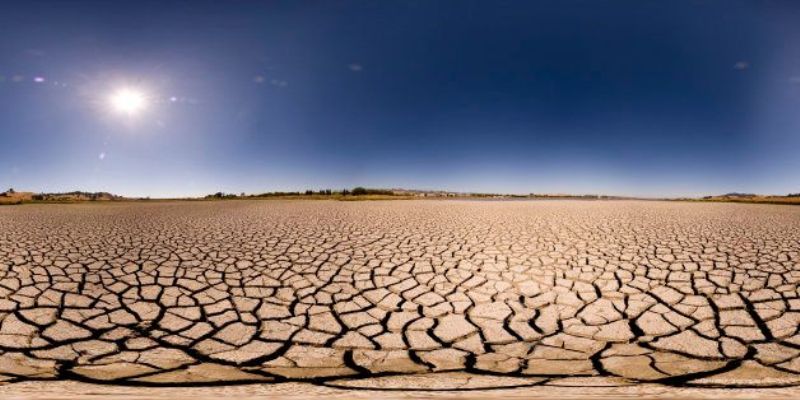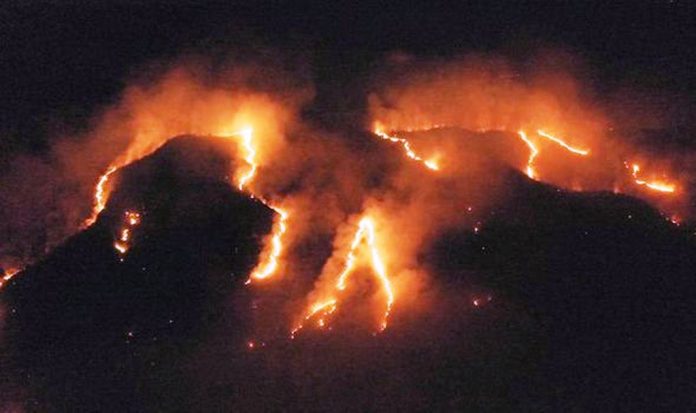
Chandra Bhushan A decade later, the carbon market has collapsed and the developed countries’ funding commitments for REDD+ have also been much lower than expected.Land degradation and deforestation are responsible for more than 20% of the global greenhouse gas (GHG) emissions. The one thing that worries climate scientists the most is the positive feedback loop. This is a process where changing one quantity changes the second one, and the change in the second quantity, in turn, changes the first. Scientists fear that a positive feedback loop will lead to a tipping point, beyond which the climate crisis may spiral out of control.

Desertification, melting of the Arctic ice caps, and thawing of the Siberian permafrost are some examples of the positive feedback loop. For instance, global warming is speeding up desertification by increasing the frequency and intensity of droughts, floods and forest fires. Desertification, in turn, is releasing large quantities of soil carbon into the atmosphere, further exacerbating warming. Similarly, global warming has started to thaw the Siberian permafrost. This could potentially release billions of tonnes of CO2 into the atmosphere, warming the earth further and causing more permafrost to thaw. These are nightmarish scenarios, but they may slowly be becoming a reality. The fires raging in Brazil’s Amazon rainforest are a vivid manifestation of this.
================
The Amazon Basin, most of which is in Brazil, is the world’s largest rainforest, spanning four million km2. In the last 50 years, about 0.8 million km2 of the Amazon, equal to the entire forest and tree cover of India, has been lost to logging, farming, mining and other infrastructure developments. Scientists believe that if the Amazon loses another 3-8% of its forest, deforestation will start to feed on itself. Beyond this tipping point, forest cover would keep shrinking despite efforts to stop it. Eventually, much of the Amazon would become dry grassland, known as cerrado. When this happens, the Amazon will release billions of tonnes of carbon into the atmosphere, worsening global warming. Illegal logging, forest fires and climate change bring the tipping point closer every year.
================
It is important to understand that what is happening in the Amazon rainforest is not new. Deforestation in the Brazilian Amazon has been taking place at an industrial scale since the 1970s, peaking in 1995, when about 29,000 km2 forest was razed. From 2004 to 2012, the rate of deforestation slowed because of domestic and international pressure. In 2008, an international Amazon Fund was created to help pay for protection. The result of all these was that deforestation reached its record low level of 4,500 km2 in 2012. Since then, deforestation has been on the rise again. Under President Jair Bolsonaro, an environment sceptic, the rate of deforestation has further accelerated.
Bolsonaro has told the world that what happens in the Brazilian Amazon is Brazil’s business. But, is it? Amazon produces about 20% of earth’s oxygen and regulates the water cycle in the whole of South America. It is a net carbon sink; in normal years, it absorbs more than two billion tonnes of CO2. The destruction of the Amazon, therefore, has global ramifications and requires global attention. But, global attention is also required for deforestation and land degradation in other parts of the world. The Amazon fire only exemplifies what is a global problem.

It is estimated that the world lost more than 1.29 million km2 of forests during 1990–2015, at a rate of more than 50,000 km2 per year. Brazil accounted for about 30% of this loss. Large-scale deforestation is also happening is Southeast Asia and Africa. At the existing pace of deforestation, the world is likely to lose another 2.89 million km2 of forests by the 2040s. Similarly, the world is losing 120,000 km2 of land every year due to land degradation.
Land degradation and deforestation are responsible for more than 20% of the global greenhouse gas (GHG) emissions. The Intergovernmental Panel on Climate Change’s Special Report on Global Warming of 1.5°C clearly states that we will not only have to stop these emissions but also deploy large-scale ‘carbon removal’ from the atmosphere to meet the target of keeping the global temperature increase within 1.5°C. The best way to remove carbon is by sequestering it in its natural sinks—forests, grasslands and soil. This also has the added benefit of halting desertification and land degradation, which is threatening the world’s food and water security. So, how do we get these solutions implemented?
================
Ricardo Salles, the environment minister of Brazil has reportedly said, “The international community can’t give Brazil the onus of being the world’s lungs without any benefits.” He is right. Developed countries, responsible for the bulk of emissions, should support Brazil in protecting the Amazon. In 2007, a global mechanism called REDD+ (Reducing Emissions from Deforestation and Forest Degradation) was started to incentivise forest conservation in developing countries by providing them with funds and allowing them to sell carbon credits to developed countries. A decade later, the carbon market has collapsed and the developed countries’ funding commitments for REDD+ have also been much lower than expected.
================
My colleagues and I studied in detail the implementation of REDD+ in India and a few African countries, and concluded that lessons from REDD+ can be used to design a new global mechanism to enhance natural carbon sinks in land and forests. We call this the Sink Mechanism. Our proposal, which we discussed at the UN Climate Convention last year, has the following elements:

First, the sink mechanism must be owned by communities. REDD+ was captured by forest departments and large-forest owners, with little benefits to communities. But, studies show that indigenous people and local communities are capable of achieving excellent forest conservation outcomes at a much lower cost. The sink mechanism will work if millions of forest dwellers and farmers are incentivised to reverse land- and forest-degradation.
Second, the mechanism must be to promote sustainable forest and farm management practices, which lead to social, economic and ecological benefits. Scaling of carbon sequestration would be one of its co-benefits.
Third, land- and forest-based mechanisms cannot be sustained on carbon credits. They cannot be left to the mercy of markets. A non-market approach is needed to finance the sink mechanism. We, therefore, need to design a non-market mechanism where funds are mobilised to build the capacities of communities and local governments. Based on their performance, they can be rewarded for achieving emissions reduction and carbon stock enhancement.
Last, any global mechanism cannot depend solely on funding from developed countries. The REDD+ experience showed that once foreign funding ceases, projects become unsustainable. So, the funds for the sink mechanism have be a combination of domestic and international resources. But, even in this cooperative framework, developed countries will have to make far greater funding commitments than what they have done so far.
================
Halting forest loss along with reforesting could provide 150–200 billion tonnes of carbon mitigation between 2020 and 2050. Farmlands in dry land areas can sequester an additional 30–60 billion tonnes of carbon during the same period. Together, a sink mechanism that addresses both forests and farmlands can mitigate more than one-third of the climate crisis. What we need is to urgently bring countries together and agree on this collaborative framework to fight the climate crisis.
================
Chandra Bhushan, Deputy director general, CSE, Twitter: @Bh_Chandra
































